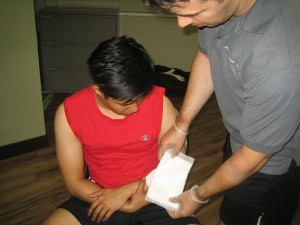A skin flap is a healthy skin that is partly disconnected and moved to cover a wound. It may contain skin and fat or skin, fat and muscle. Sometimes a skin flap is still connected to its original area and one end still connected to a blood vessel. A flat can be moved to a new area and the blood vessel that is still attached to the flap is surgically reconnected which is called a free flap. The area from where the flap is taken is called the donor site. After the surgery, there will be two wounds, the graft or flap and the donor area.
Treatment
- Clean hands properly before touching the area to prevent the risk of infecting the wound. Wash hand thoroughly using soap and water and wear sterile latex gloves.
- Stop the bleeding by pressing a sterile pad or dressing over the area. Apply a steady pressure on the wound. Use Telfa dressings or non-adhesive gauze. If bleeding seep through the dressing, place gauze on top of it until the bleeding has stopped.
A skin flap is a healthy skin that is partly disconnected and moved to cover a wound. - In case the wound is on the limb elevate the area to lessen the flow of blood to the affected area. If on the arm, raise the area while placing pressure.
- Rinse the area around the wound using cool water to remove any debris.
- Clean the wound using saline solution to make the skin elastic and making it easier to reconnect the border of the wound. Saline solution is made by mixing ½ teaspoon of salt to a cup of water. Boil the mixture for at least 15 minutes. Let it cool.
- Remove any debris in the wound using a tweezers. Sterilize the tweezers using rubbing alcohol before using them.
- Before applying dressing on the wound, apply a thin layer of prescribed antibiotic ointment or cream. The cream or ointment keeps the area moist; lessen the risk of developing infection and for fast healing of the condition.
- Apply dressing or covering over the wound to keep the affected area clean and lessen the risk of developing infections. Use Telfa or the soft silicone-coated dressings. Change dressings regularly at least once every day.
- Once the wound is already healed and there is no risk of developing an infection, remove the dressing, and leave the area uncovered. Expose the area to the air for fast healing of the condition.
- Take the prescribed pain medication to lessen the pain and the swelling.
- If possible elevate the wound above the level of the heart to lessen the swelling. Another alternative is raising the area in couple of pillows to keep it elevated.
Tips
- Avoid performing movements that cause stretching or injuring the flap or graft.
- Avoid scratching or picking the wound as it heals to prevent further damage and worsen the condition.
- When taking a bath or showering, cover the affected area using a plastic bag to keep it dry.
More Information
The details posted on this page on a skin flap is for learning purposes only. To learn to recognize and manage this type of skin wound, enroll in a first aid course with one of our training providers.

